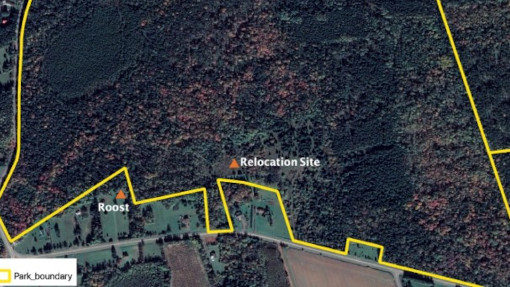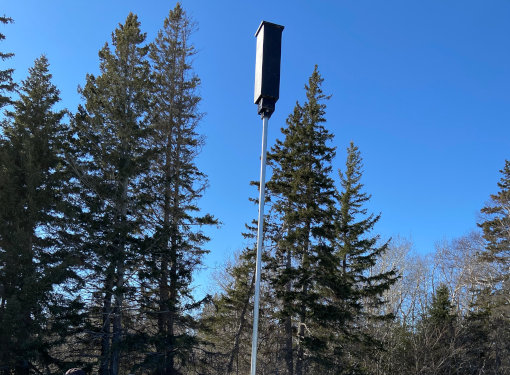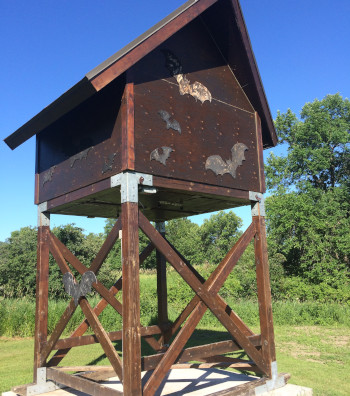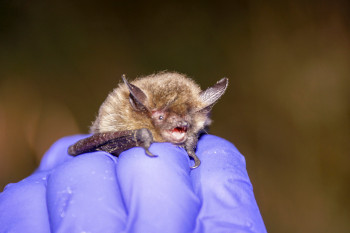
Helping bats find a home
Parks Canada is working with partners, including local landowners, to maintain roosting places for bats
Call it a “housing first” approach for bats.
In 2019, staff at Prince Edward Island National Park, in collaboration with the University of Waterloo, discovered that an old building right beside the park served as an important maternity roost for the Little Brown Myotis (bat).
This small bat is one of three bat species listed as Endangered under Canada’s Species at Risk Act. It’s under threat from loss of habitat and (particularly) White-nose Syndrome, a fungal disease that is wiping out bats across North America.
So when park staff learned that that this old building was going to be demolished, they came up with a novel plan. They asked the owners if they could move components of the building inside the park boundaries.
Landowners Andrea and David Shaw generously worked with park staff to postpone demolition and donate the important components of this roosting site once the bats had left for the season.
Bats like to return to the same roosting sites in the spring and fall, year after year, and staff believed it was important for this long-standing maternity roost site to remain in the landscape as a continued option for roosting bats. The new site is only 300 meters from the old one.
The image on the left shows a building with a red circle around it, to mark the location of the nesting colony. The image on the right is a map of a section of Prince Edward Island National Park showing the former location of the bat roost as well as the relocated site inside the park boundary.

Long text description
Sure enough, a few months after the move, a small number of bats were seen flying out of the relocated structure. For good measure, Parks Canada staff also put up several bat boxes near the old and new locations, and these showed signs of being used as well.
Location, location, location
Ensuring safe roosting sites is a valuable strategy for boosting the survival rates of bats. Scientists estimate that White-nose Syndrome has wiped out over 6.7 million bats across North America.
Besides roosting in human-built structures, bats also use hollow trees, hedgerows, caves, and other natural shelters. Helping them means above all protecting the habitat where these spaces are found. But some species can end up in buildings and other human-built structures, which means that bats and humans can become close neighbours… sometimes uncomfortably close.
Rouge National Urban Park in Ontario is very familiar with the challenge of helping humans and bats co-exist. Located in the heart of Canada's largest metropolitan area, the Rouge is a tapestry of natural, cultural and agricultural landscapes—with plenty of buildings.
Not only does the park have its own built infrastructure, but the tenants (farmers, for example) have houses, barns, sheds and silos on their leased properties within the park. That’s a rich array of homesteading opportunities for bats.

Preserving bat real estate in Rouge National Urban Park means establishing rapport with park tenants and adjacent private landowners. It also means implementing a thorough monitoring protocol and mitigation measures to ensure no bats are harmed when decommissioning some of the park’s old buildings that are beyond a state of repair.
Bat boxes—specially built roosts for bats—may be part of the solution. In Rouge and other Parks Canada locations, bat boxes are being explored as “compensation habitat.” Such a measure is used when (for example) an old building that is a known roosting site must be torn down, or when tenants or private landowners wish to exclude bats from entering their homes.
High-density living… without the owls
Rouge National Urban Park would like to go one step beyond the modest bat box and is exploring a “bat condo.”
The bat condo will serve to compensate for the removal of a known maternity roost currently situated within one of the dilapidated buildings at Rouge.
This structure for bats, roughly 2.4 metres square, will stand at least 3.6 metres above the ground. It will include a four-chamber nursery space for bat mothers. The fly-in entrances will be 10 centimetres high, to exclude owls that have been known to infiltrate other “bat condos.”
The “bat condo” is designed to mimic the conditions found in human-built structures.
“Since it’s so large,” says Juliana Skuza, resource conservation officer at Rouge National Urban Park, “we are hoping it can closely replicate the different microclimates available in the existing maternity roost.”

An action plan for an ecological community
Rouge National Urban Park recently collaborated with Indigenous partners and external stakeholders to propose a Species at Risk Multi-species Action Plan. These action plans, produced by Parks Canada places across the country, take an ecosystem approach to conservation, focusing on protecting an assemblage of species found in a particular area.
Three species of bat are identified in the Rouge National Urban Park plan (Little Brown Myotis, Northern Myotis and the Tri-colored Bat) along with other species that use human-built structures (Barn Swallows, Chimney Swifts, Eastern Milksnakes and Eastern Ribbonsnakes).
It just goes to show that in Rouge, as in many Parks Canada locations, existing human-built structures are managed as part of the ecosystem. Preserving old structures—or providing substitute habitat when they are torn down—can benefit birds and reptiles as well as bats.
Bat box questions
While bat boxes of various shapes and sizes are being used across the country, conservationists are still unsure which designs work best.
That’s why Rouge National Urban Park, Prince Edward Island National Park and seven other Parks Canada-administered places are taking part in the Batbox Project. Led by PhD student Karen Vanderwolf at Trent University, the project is a joint effort involving the Wildlife Conservation Society (Canada) and the Canadian Wildlife Federation.
The study is open to anybody with a bat box. Participants are asked to complete an online survey about their bat boxes and to count the bats emerging from the shelter at sunset.
An optional activity is to install a microclimate logger, to measure temperature and relative humidity inside bat boxes. (One concern about bat boxes is whether certain designs can lead to overheating, which can be fatal for bats).
Beyond preserving natural bat habitat and putting up compensation roosts, Parks Canada has an additional strategy for helping bats—education.
The worldwide value of bats in controlling insect pests is estimated in the billions of dollars. In some areas of the globe they are pollinators, and also help disperse seeds.
Bats need their space in our world, and that can only be secured when the old lumber of mistrust and misinformation is cleared away.

Bats do so much for us, from keeping insect pests in check to dispersing seeds and pollinating plants!
Check out Bat Week, an annual international celebration, for bat events and adventures:
- Date modified :